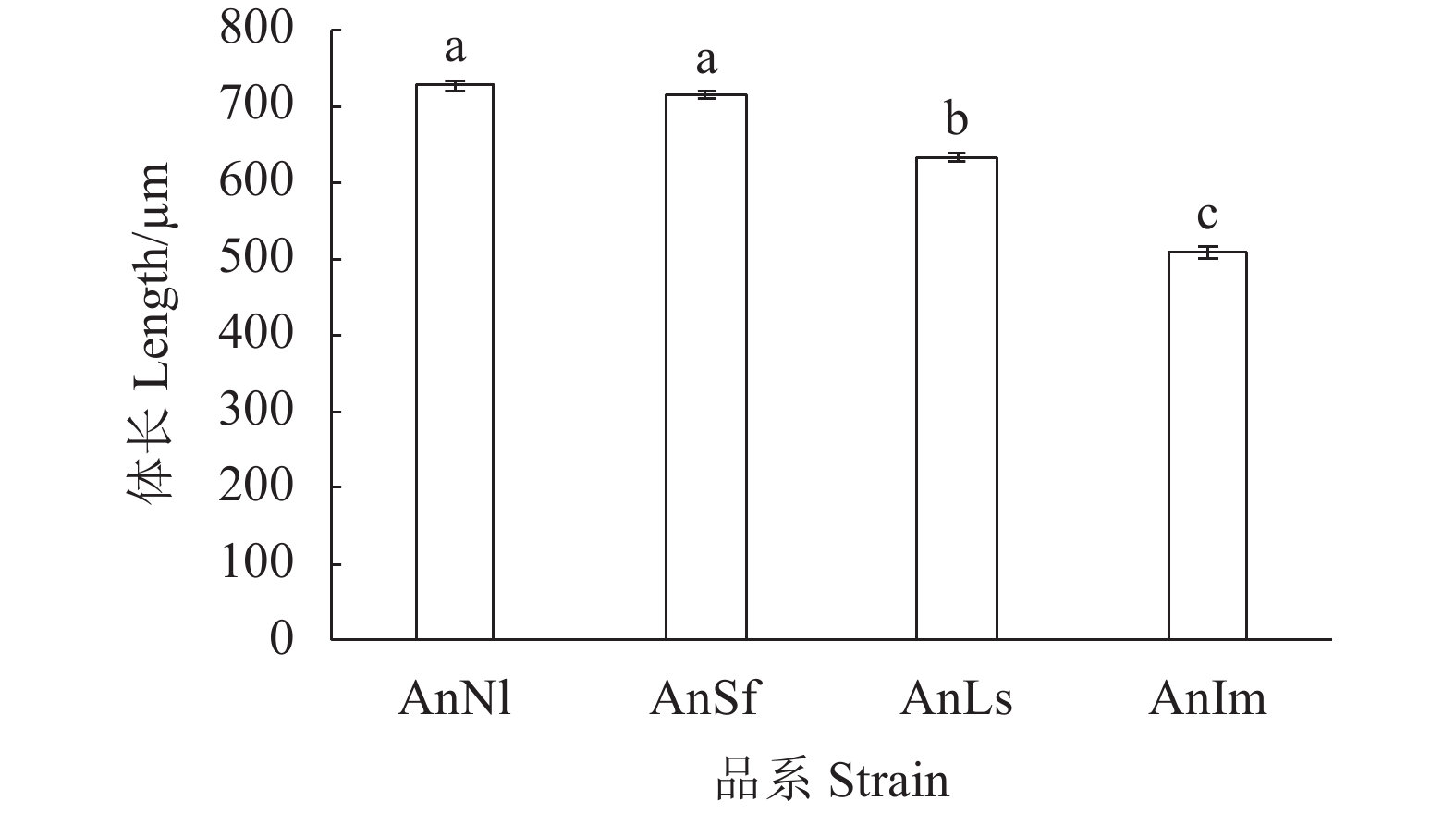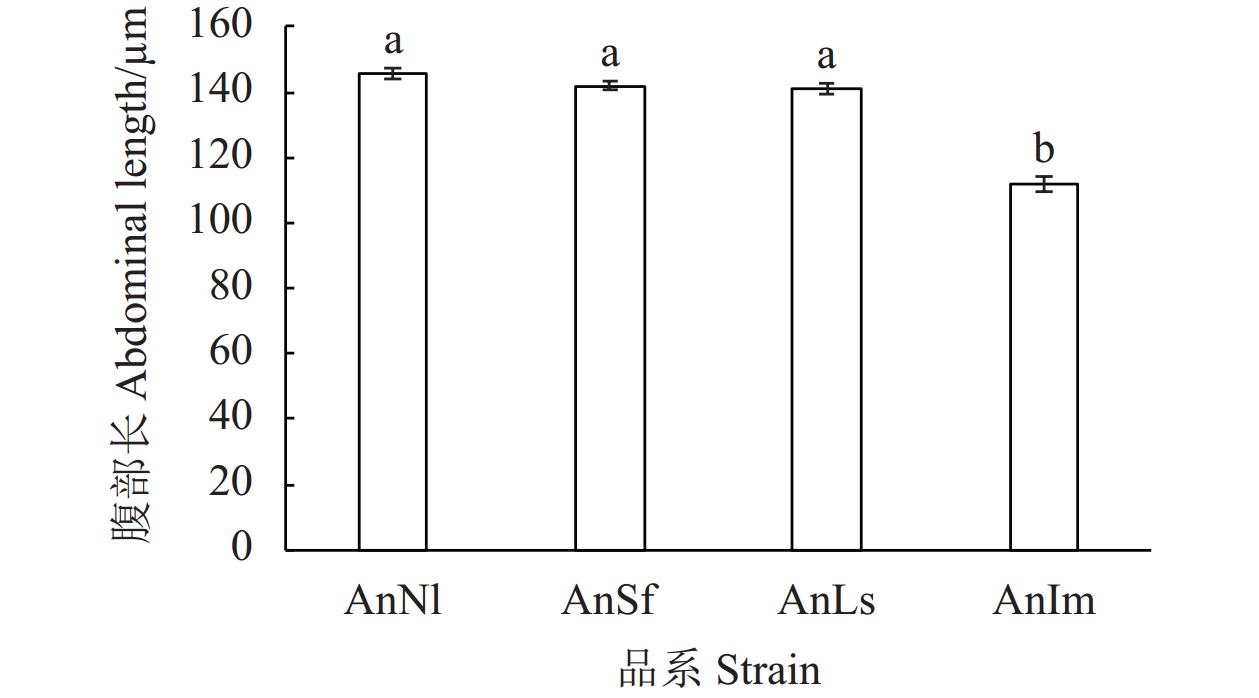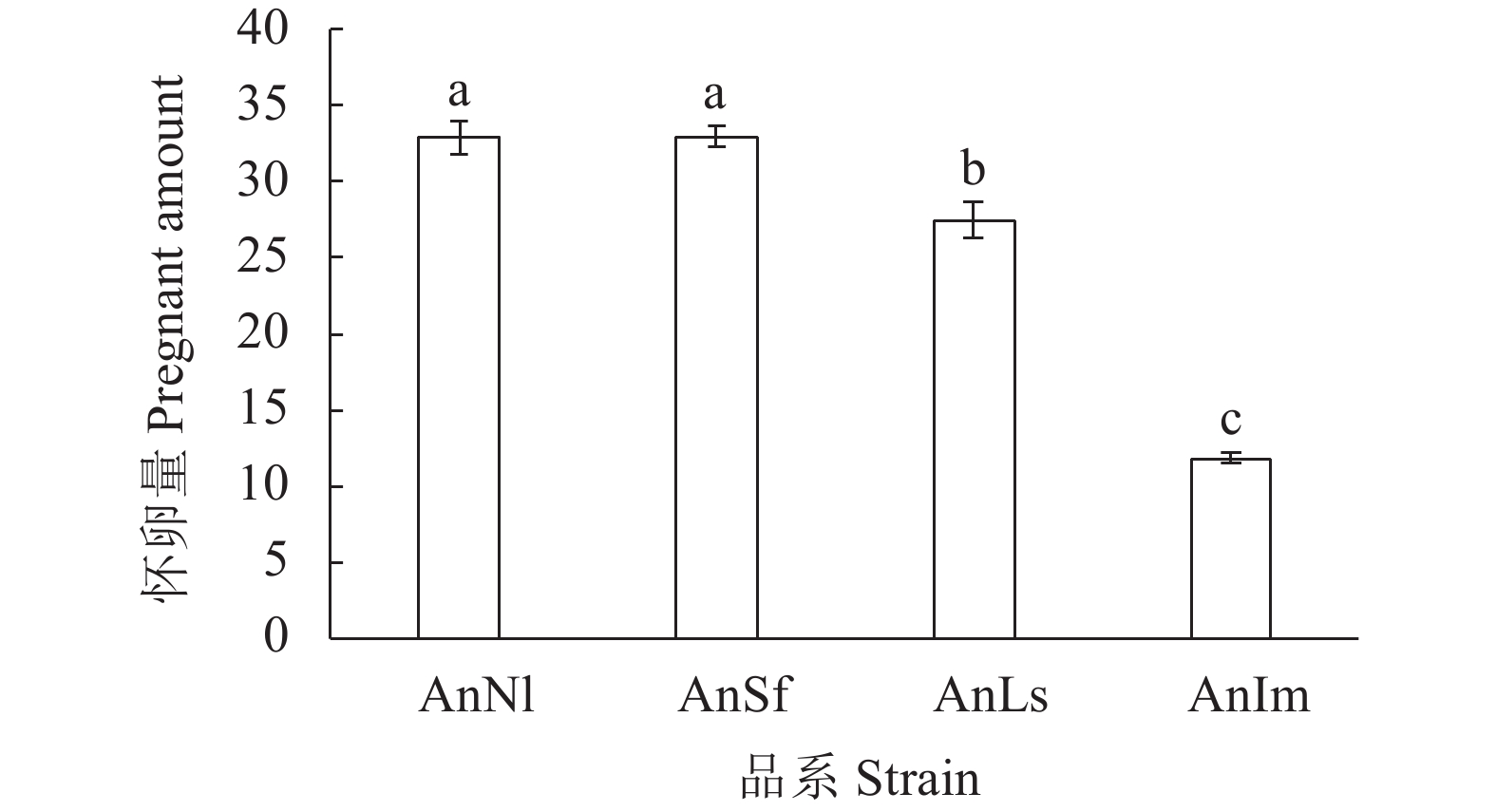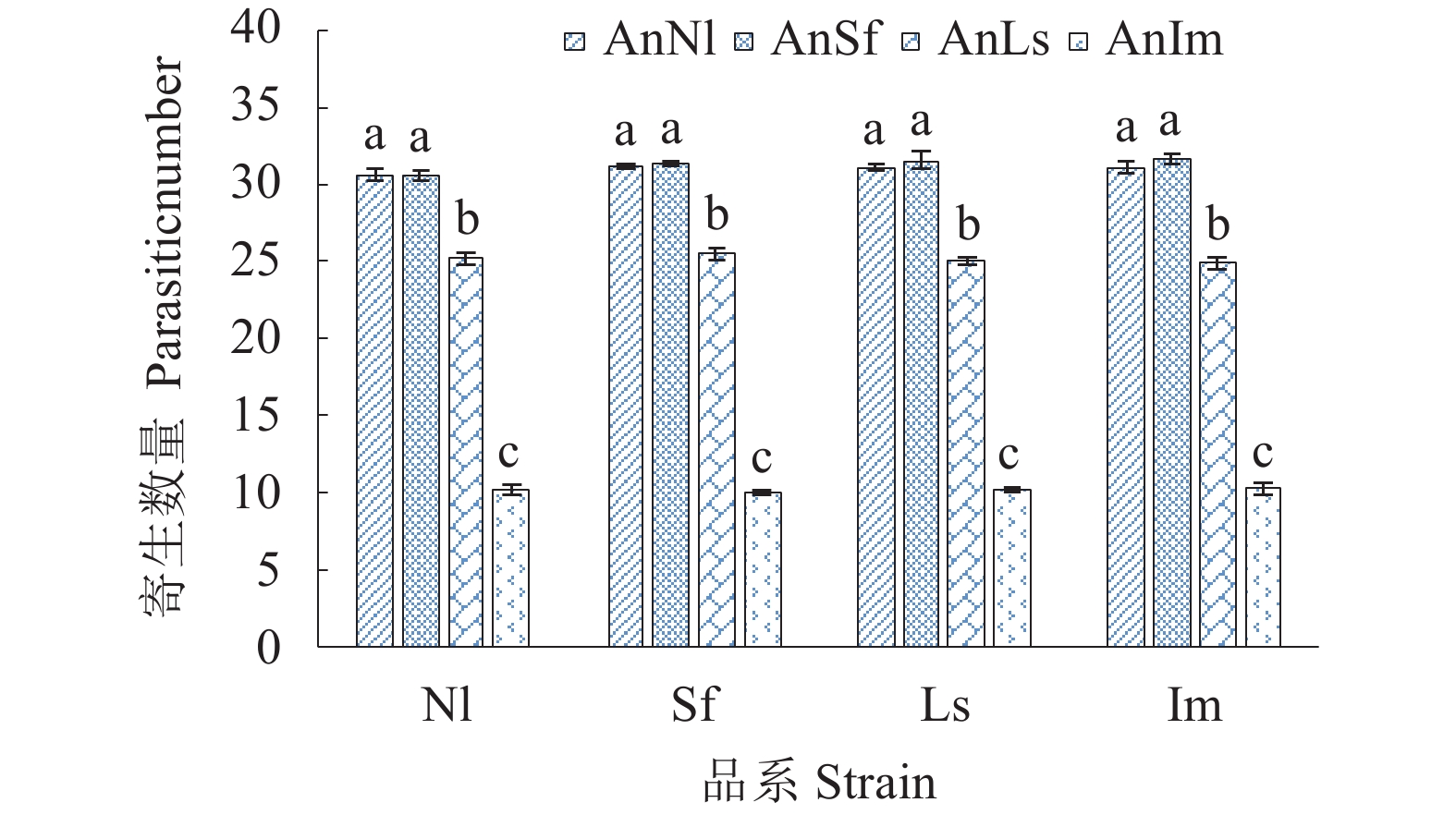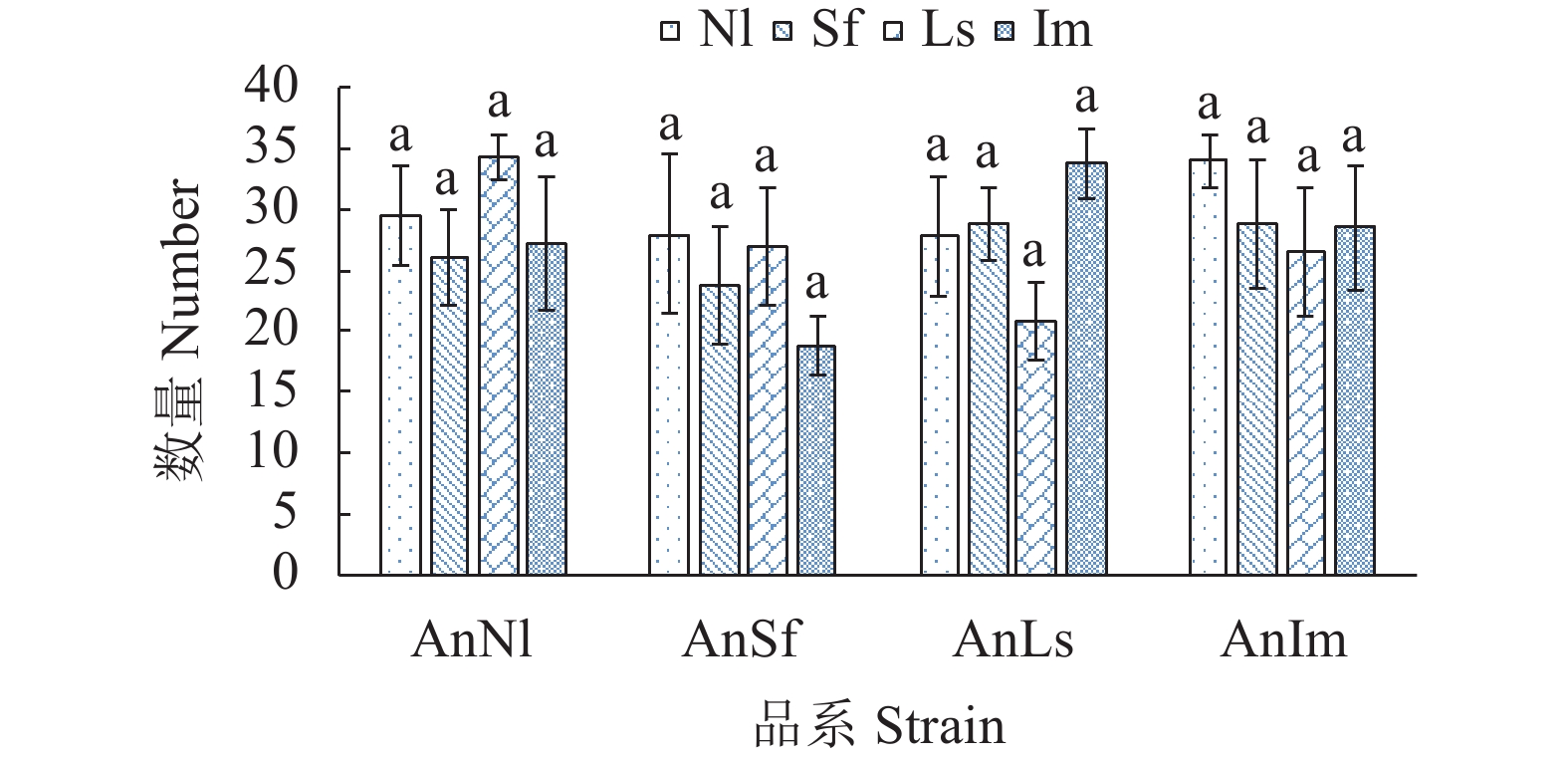Host Selection of Anagrus nilaparvatae
-
摘要:
目的 探明繁殖寄主对稻虱缨小蜂生物学特性的影响,为室内大量扩繁稻虱缨小蜂提供理论依据。 方法 分别以褐飞虱、白背飞虱、灰飞虱和小宽头飞虱为寄主繁殖对应的稻虱缨小蜂品系,比较不同品系稻虱缨小蜂个体大小、体色、怀卵量、寄生力、羽化率、性比和成虫寿命等适合度指标,以及不同品系对寄主的偏好差异。 结果 以褐飞虱、白背飞虱、灰飞虱和小宽头飞虱为寄主的稻虱缨小蜂品系成虫体长分别为728.03、715.5 、633.17 、509.1 μm,不同品系成虫体长之间存在差异,以褐飞虱和白背飞虱为寄主的品系体长最长,显著长于灰飞虱和小宽头飞虱的品系。不同寄主对稻虱缨小蜂的体色也有影响,以褐飞虱、白背飞虱和灰飞虱为寄主的品系体色呈浅橙色,少数个体呈黄绿色,小宽头飞虱品系体色较深,呈橙红色,无黄绿色个体。不同品系怀卵量分别为:褐飞虱32.93粒、白背飞虱32.97粒、灰飞虱27.47粒和小宽头飞虱11.83粒,除褐飞虱品系与白背飞虱品系的怀卵量之间无显著差异外,不同品系怀卵量之间存在显著差异。不同品系寄生力大小为褐飞虱=白背飞虱>灰飞虱>小宽头飞虱。不同品系的羽化率、性比和成虫寿命之间无显著差异。不同品系对寄主的选择为随机,未表现出对某一寄主的偏好。不同品系内禀增长力rm由大到小分别为褐飞虱 0.1531 >白背飞虱0.1482 >灰飞虱0.1307 >小宽头飞虱0.0427 。结论 以褐飞虱和白背飞虱为寄主的稻虱缨小蜂品系具有怀卵量大、寄生力强、内禀增长力大的优势。褐飞虱和白背飞虱是稻虱缨小蜂扩繁的合适寄主。 Abstract:Objective Reproductive biology of Anagrus nilaparvatae strains (Ans) that lay eggs on different pests was studied to determine the best parasitoid/host matches for biocontrol. Method Nilaparvata lugens (Nl),Sogatella furcifera (Sf), Laodelphax striatellus (Ls), and Ishiharodelphax matsuyamensis (Im) were used in an indoor experiment as the hosts to study the reproductive behavior of Ans. Fitness of parasitoid/pest pairings as well as host preference by specific stains of An were determined based upon the size, body color, egg load, parasitism capacity, larva emergence, sex ratio, and lifespan of the wasps. Result The body lengths of different species of adult Ans varied significantly, as it was 728.03 μm for those hosted on Nl (AnNl), 715.5 μm on Sf (AnSf), 633.17 μm on Ls (AnLs), and 509.1 μm on Im(AnIm) . The color of wasp body also varied depending upon the pests they chose to lay eggs on. For instance, AnNl, AnSf, and AnLs were mostly light orange, with a few yellowish green, in color, but all AnIm had dark reddish orange bodies. Significant differences in fecundity existed among the strains as well. The egg counts per female were similar between AnNl at 32.93 and AnSf at 32.97 but 27.47 for AnLs and 11.83 for AnIm. The parasitism of these wasps ranked AnNl or AnSf>AnLs>AnIm. On the other hand, no significant differences were detected on the rate of larvae emerged from eggs, male/female ratio, or lifespan of them. Nor was on host selection—they simply deposited eggs randomly based on availability. The intrinsic rate of increase (rm) of AnNl was the highest at 0.1531 followed by 0.1482 of AnSf, 0.1307 of AnLs, and 0.0427 of AnIm. Conclusion The strains of An that parasited on Nl and Sf had significantly greater egg load, parasitism capability, and rm than those did on Ls or Im . Hence, they could be the better candidates to be artificially propagated for biocontrol on the pests. -
Key words:
- Anagrus nilaparvatae /
- host /
- fitness
-
表 1 不同寄主稻虱缨小蜂品系的羽化率、雌成虫比例和成虫寿命
Table 1. Emergence rate, proportion of female adults, and lifespan of Ans
寄主
Host羽化率
Eclosion rate/%雌成虫比例
Female percentages/%成虫寿命
Adult lifespan/d褐飞虱
N. lugens96.34±0.49a 51.48±0.17a 3.03±0.02a 白背飞虱
S. furcifera96.48±0.40a 51.19±0.16a 3.00±0.03a 灰飞虱
L. striatellus96.11±0.46a 51.42±0.21a 2.98±0.10a 小宽头飞虱
I. matsuyamensis96.34±0.47a 51.83±0.37a 3.00±0.11a 表 2 不同寄主稻虱缨小蜂品系的种群参数
Table 2. Population parameters of Ans
寄主
Host净增
殖率R0
Net
reproductive
rate平均世代
周期T
Mean
generation
time/d内禀
增长率rm
Intrinsic
rate of
increase周限
增长率λ
Finite rate of
increase褐飞虱
N. lugens5.3144 10.91 0.1531 1.1654 白背飞虱
S. furcifera5.0064 10.87 0.1482 1.1598 灰飞虱
L. striatellus4.1934 10.96 0.1307 1.1397 小宽头飞虱
I. matsuyamensis1.5931 10.91 0.0427 1.0436 -
[1] WU A Z, ZHAO Y, QU Z C, et al. Subcellular localization of the stripe disease-specific protein encoded by rice stripe virus (RSV) in its vector, the small brown planthopper, Laodelphax striatellus [J]. Chinese Science Bulletin, 2001, 46(21): 1819−1822. doi: 10.1007/BF02900559 [2] LIU Z W, HAN Z J. Fitness costs of laboratory-selected imidacloprid resistance in the brown planthopper, Nilaparvata lugens Stål [J]. Pest Management Science, 2006, 62(3): 279−282. doi: 10.1002/ps.1169 [3] WANG Y H, GAO C F, ZHU Y C, et al. Imidacloprid susceptibility survey and selection risk assessment in field populations of Nilaparvata lugens (Homoptera: Delphacidae)[J]. Journal of Economic Entomology, 2008, 101(2): 515-522. [4] 全国农业技术推广服务中心. 2023年全国农业有害生物抗药性监测报告[OL]. [2024-02-27]. 全国农技推广网https://www.natesc.org.cn/news. [5] YU X P, BARRION A T, LU Z X. A taxonomic investigation on egg parasitoid, Anagrus of rice planthopper in Zhejiang Province [J]. Chinese Rice Research Newsletter, 2001(3): 8−9. [6] 毛润乾, 古德祥, 张古忍, 等. 稻田飞虱卵寄生蜂群落结构和动态的初步研究 [J]. 昆虫学报, 2002, 45(3):408−412. doi: 10.3321/j.issn:0454-6296.2002.03.024MAO R Q, GU D X, ZHANG G R, et al. A preliminary investigation on structure and dynamics of egg parasitoid community on the brown planthopper in rice field [J]. Acta Entomologica Sinica, 2002, 45(3): 408−412. (in Chinese) doi: 10.3321/j.issn:0454-6296.2002.03.024 [7] 祝增荣, 陈建明, 程家安, 等. 双季稻白背飞虱的被寄生率暨存活率分析 [J]. 中国生物防治, 2004, 20(1):21−26.ZHU Z R, CHEN J M, CHENG J A, et al. Parasitism and survival analysis of Sogatella furcifera in double-cropping rice fields [J]. Chinese Journal of Biological Control, 2004, 20(1): 21−26. (in Chinese) [8] 郑许松, 俞晓平, 吕仲贤, 等. 不同营养源对稻虱缨小蜂寿命及寄生能力的影响 [J]. 应用生态学报, 2003, 14(10):1751−1755. doi: 10.3321/j.issn:1001-9332.2003.10.036ZHENG X S, YU X P, LU Z X, et al. Effects of different nutritional resources on the longevity and parasitic ability of egg parasitoid Anagrus nilaparvatae [J]. Chinese Journal of Applied Ecology, 2003, 14(10): 1751−1755. (in Chinese) doi: 10.3321/j.issn:1001-9332.2003.10.036 [9] 林庆胜, 黄寿山, 胡美英, 等. 稻虱缨小蜂(Anagrus nilaparvatae)在两种稻飞虱上的生殖力及其应用潜能 [J]. 生态学报, 2009, 29(8):4295−4302. doi: 10.3321/j.issn:1000-0933.2009.08.033LIN Q S, HUANG S S, HU M Y, et al. Fecundity of Anagrus nilaparvatae parasitizing two rice hopper and the evaluation of its application potential [J]. Acta Ecologica Sinica, 2009, 29(8): 4295−4302. (in Chinese) doi: 10.3321/j.issn:1000-0933.2009.08.033 [10] MIURA T, HIRASHIMA Y, WONGSIRI T. Egg and nymphal parasites of rice leafhoppers and planthoppers. a result of field studies in Thailand in 1977 [J]. Esakia, 1979, 13: 21−44. doi: 10.5109/2385 [11] MIURA T, HIRASHIMA Y, CHUJO M, et al. Egg and nymphal parasites of rice leafhoppers and planthoppers. a result of field studies in Taiwan in 1979 (part 1) [J]. Esakia, 1981, 16: 39−50. doi: 10.5109/2411 [12] 罗肖南, 卓文禧. 稻飞虱卵寄生蜂—缨小蜂生物学特性及保护利用的探讨 [J]. 福建农学院学报, 1980, 9(2):44−60.LUO X N, ZHUO W X. Investigations on the bionomics and utilization of mymarid egg-parasites of rice planthoppers [J]. Journal of Fujian Agriculture and Forestry University (Natural Science Edition), 1980, 9(2): 44−60. (in Chinese) [13] 朱平阳, 郑许松, 姚晓明, 等. 提高稻飞虱卵期天敌控害能力的稻田生态工程技术 [J]. 中国植保导刊, 2015, 35(7):27−32,56. doi: 10.3969/j.issn.1672-6820.2015.07.005ZHU P Y, ZHENG X S, YAO X M, et al. Ecological engineering technology for enhancement of biological control capacity of egg parasitoids against rice planthoppers in paddy fields [J]. China Plant Protection, 2015, 35(7): 27−32,56. (in Chinese) doi: 10.3969/j.issn.1672-6820.2015.07.005 [14] 申昭灿, 陈龙, 邬家栋, 等. 稻田寄生蜂和鳞翅目昆虫的多样性及变化动态 [J]. 中国生物防治学报, 2017, 33(5):590−596.SHEN Z C, CHEN L, WU J D, et al. Diversity and dynamic of parasitoid wasps and lepidopteran insects during growth stages of rice [J]. Chinese Journal of Biological Control, 2017, 33(5): 590−596. (in Chinese) [15] 王野岸, 庞雄飞. 稻虱缨小蜂寄主范围的调查 [J]. 昆虫天敌, 1986, 8(4):225−229.WANG Y A, PANG X F. Investigation of the host range of Anagrus nilaparvatae (Hymenoptera: Mymaridae) [J]. Natural Enemies of Insects, 1986, 8(4): 225−229. (in Chinese) [16] 徐红星, 于莹, 郑许松, 等. 模拟干旱胁迫对稻虱缨小蜂的影响 [J]. 植物保护学报, 2017, 44(1):54−59.XU H X, YU Y, ZHENG X S, et al. Effects of simulated drought stress on the ecological fitness of Anagrus nilaparvatae Pang et Wang [J]. Journal of Plant Protection, 2017, 44(1): 54−59. (in Chinese) [17] 刘大卫. 两种褐飞虱卵寄生蜂的寄生行为及种间竞争初探[D]. 福州: 福建农林大学, 2023.LIU D W. Preliminary exploration on the parasitic behavior and interspecific competition of two egg parasitoid wasps on brown rice planthopper Nilaparvata lugens (Stål) [D]. Fuzhou: Fujian Agriculture and Forestry University, 2023. (in Chinese) [18] 胡进耀, 苏智先, 陈光升, 等. 水稻, 褐飞虱, 稻虱缨小蜂的化学生态研究概述 [J]. 内江师范学院学报, 2004, 19(6):74−78. doi: 10.3969/j.issn.1671-1785.2004.06.017HU J Y, SU Z X, CHEN G S, et al. Study in chemical ecology of tritrophic interactions among rice, Nilaparvata lugens and Anagrus nilaparvatae [J]. Journal of Neijiang Teachers College, 2004, 19(6): 74−78. (in Chinese) doi: 10.3969/j.issn.1671-1785.2004.06.017 [19] 胡进生. 二种稻虱缨小蜂空间寄生习性的观察 [J]. 昆虫知识, 1992, 29(2):107−109.HU J S. Observation on the spatial parasitism habits of two species of Anagrus nilaparvatae [J]. Entomological Knowledge, 1992, 29(2): 107−109. (in Chinese) [20] 程遐年, 徐国民. 两种稻虱缨小蜂种群生态的比较 [J]. 昆虫学报, 1991, 34(4):405−412.CHENG X N, XU G M. Comparison of population ecology between two mymarid egg parasitoids of rice planthoppers [J]. Acta Entomologica Sinica, 1991, 34(4): 405−412. (in Chinese) [21] 娄永根, 程家安. 水稻品种对稻虱缨小蜂发育、存活及繁殖的影响 [J]. 昆虫学报, 1996, 39(1):28−36.LOU Y G, CHENG J A. Influence of rice varieties on development, survival and fecundity of Anagrus nilaparvatae Pang et Wang [J]. Acta Entomologica Sinica, 1996, 39(1): 28−36. (in Chinese) [22] 娄永根, 程家安, 平霄飞, 等. 稻虱缨小蜂对褐飞虱和白背飞虱卵的识别机制 [J]. 昆虫学报, 2002, 45(6):770−776. doi: 10.3321/j.issn:0454-6296.2002.06.013LOU Y G, CHENG J A, PING X F, et al. Discrimination by the egg parasitoid Anagrus nilaparvatae between two hosts, Nilaparvata lugens and Sogatella furcifera [J]. Acta Entomologica Sinica, 2002, 45(6): 770−776. (in Chinese) doi: 10.3321/j.issn:0454-6296.2002.06.013 [23] 祝增荣, 程家安, 陈琇. 稻虱缨小蜂的寄主选择性和适宜性 [J]. 昆虫学报, 1993, 36(4):430−437. doi: 10.3321/j.issn:0454-6296.1993.04.001ZHU Z R, CHENG J A, CHEN X. Host preference and suitability of Anagrus nilaparvatae [J]. Acta Entomologica Sinica, 1993, 36(4): 430−437. (in Chinese) doi: 10.3321/j.issn:0454-6296.1993.04.001 [24] 刘树生. 昆虫生命表制作与分析中的几个问题 [J]. 昆虫知识, 1986, 23(1):41−43,45.LIU S S. Several problems in the production and analysis of insect life table [J]. Entomological Knowledge, 1986, 23(1): 41−43,45. (in Chinese) [25] WYCKHUYS K A G, STONE L, DESNEUX N, et al. Parasitism of the soybean aphid, Aphis glycines by Binodoxys communis: The role of aphid defensive behaviour and parasitoid reproductive performance [J]. Bulletin of Entomological Research, 2008, 98(4): 361−370. doi: 10.1017/S000748530800566X [26] PEKAS A, TENA A, HARVEY J A, et al. Host size and spatiotemporal patterns mediate the coexistence of specialist parasitoids [J]. Ecology, 2016, 97(5): 1345−1356. doi: 10.1890/15-0118.1 [27] CLOUTIER C, DUPERRON J, TERTULIANO M, et al. Host instar, body size and fitness in the koinobiotic parasitoid Aphidius nigripes [J]. Entomologia Experimentalis et Applicata, 2000, 97(1): 29−40. doi: 10.1046/j.1570-7458.2000.00713.x [28] CHAU A, MACKAUER M. Preference of the aphid parasitoid Monoctonus paulensis (Hymenoptera: Braconidae, Aphidiinae) for different aphid species: Female choice and offspring survival [J]. Biological Control, 2001, 20(1): 30−38. doi: 10.1006/bcon.2000.0881 [29] BAI B R, LUCK R F, FORSTER L, et al. The effect of host size on quality attributes of the egg parasitoid, Trichogramma pretiosum [J]. Entomologia Experimentalis et Applicata, 1992, 64(1): 37−48. doi: 10.1111/j.1570-7458.1992.tb01592.x [30] GREENBERG S M, NORDLUND D A, WU Z X. Influence of rearing host on adult size and ovipositional behavior of mass produced Female Trichogramma minutum Riley and Trichogramma pretiosumRiley (Hymenoptera: Trichogrammatidae) [J]. Biological Control, 1998, 11(1): 43−48. doi: 10.1006/bcon.1997.0582 [31] LIU P C, ZHAO B, CAO D D, et al. Oviposition decisions in an endoparasitoid under self-superparasitism conditions [J]. Journal of Asia-Pacific Entomology, 2021, 24(1): 443−447. doi: 10.1016/j.aspen.2020.10.013 [32] SMITH M A, CORNELL H V. Hopkins host-selection in Nasonia vitripennis and its implications for sympatric speciation [J]. Animal Behaviour, 1979, 27: 365−370. doi: 10.1016/0003-3472(79)90170-2 [33] OHTA I, HONDA K I. Use of Sitobion akebiae (Hemiptera: Aphididae) as an alternative host aphid for a banker-plant system using an indigenous parasitoid, Aphidius gifuensis (Hymenoptera: Braconidae) [J]. Applied Entomology and Zoology, 2010, 45(2): 233−238. doi: 10.1303/aez.2010.233 [34] 王娟, 王孟卿, 刘晨曦, 等. 丽蚜小蜂的粉虱寄主选择性及后代蜂发育适合度 [J]. 中国生物防治学报, 2019, 35(2):159−166.WANG J, WANG M Q, LIU C X, et al. Host selection of Encarsia formosa gahan to whiteflies and developmental performances of the parasitoid offspring [J]. Chinese Journal of Biological Control, 2019, 35(2): 159−166. (in Chinese) [35] KING B H, NAPOLEON M E. Using effects of parasitoid size on fitness to test a host quality model assumption with the parasitoid wasp Spalangia endius [J]. Canadian Journal of Zoology, 2006, 84(11): 1678−1682. doi: 10.1139/z06-162 [36] 魏晓燕. 日本平腹小蜂对三种寄主卵的寄生选择与适应性研究[D]. 长春: 吉林农业大学, 2023.WEI X Y. Parasitism selection and adaptation of Anastatus japonicus on three host eggs [D]. Changchun: Jilin Agricultural University, 2023. (in Chinese) -








 下载:
下载:
